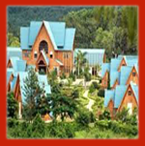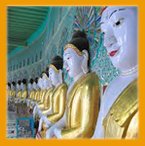|
|
 |
|
YANGON
Yangon, the capital city,
is the main gateway to Myanmar. Evergreen and
cool with lush tropical trees, shady parks and
beautiful lakes, Yangon is the beautiful
|
 |
|
 |
|
BAGAN
Bagan is notable for its
expanse of sacred geography, the number and size
of their individual ancient monuments. The ruins
of bagan
|
 |
|
 |
|
MANDALAY
MANDALAY,
the last Capital of Myanmar Kingdom is located
in the central plain of Myanmar. Once known as
the Yadanabon Kingdom, The Palace
|
|
 |
|
|
|
|
|
|
|
DESTINATION -
TAUNGGYI |
| |
»
Taunggyi (Shan State)
Taunggyi,
the capital city of Shan State in the
eastern part of Myanmar, is know for its
scenic beauty and pleasant climate. The
weather is cool all the year round and the
area is colorful with lovely flowers, pine
trees and green orchard. Being situated over
1400 meters above sea-level, Taunggyi is
ideal for holiday-makers during the summer
time.
It is situated on a high plateau
surrounded by high mountains. As Taunggyi
lies on a hill region. the atmosphere is
conducive to good health especially by means
of the salubrious mountain air. It usually
rains in Taunggyi from June to November and
average annual rainfall is 32.68 inches. To
reach Taunggyi you first have to fly to
Heho. about 40 kilometers to the West.
because the town itself does not boast an
airfield.
Taunggyi can be reached
by road. rail or air from all parts of the
country. The distance between Yangon and
Taunggyi is 456 miles and can be reached by
road directly. The road to Taunggyi is full
of bends and zigzags and. seen from above.
resembles a snake. One can have a good view
of the surrounding area while travelling
along this road. As soon as you enter
Taunggyi. the magnificent Sao Sam Htun
Hospital can be seen first and further on
there are the Taunggyi Department Store. the
market. Dhammayon (congregation hall).
Agricultural Bank. cinemas and shops and
stores. restaurants. churches. Shan State
Cultural Museum. Taunggyi Degree College.
the golf course and residential
buildings.There are pines. cherry and
eucalyptus trees growing all over the town
and the whole area is green and pleasant.
The busiest part of Taunggyi is the Myoma
Market. a place where people from the
environs used to flock only once every five
days to buy and sell their regional
products. Now it has become a daily market
and is constantly crowded with people. It is
also the gathering point of different
national races residing in Taunggyi.
|

 |
| |
»
Cultural Museum
Interesting place to visit in Taunggyi is
the Cultural Museum where cultural objects.
musical instruments. traditional dresses.
household and farm implements. paintings.
sculptures. arts and crafts of the different
national races residing in Shan State can be
seen. There are also 'Hawnans" (palatial
residences) where the Shan Sawbwas (Shan
Chieftains) used to live can also be
observed.
|
 |
| |
»
Air-Balloon Festival
In
Taunggyi. the capital city of the Shan
State. the people celebrate the Tazaungdine
festival with Kahtein (offering of monk
robes) as well as the releasing up
fire-balloons into the sky. Balloons in the
shape of elephant. ox. horse. water-buffalo.
bird. pig. fish. owl and parrot are
released. The Taunggyi festival is the
biggest festival in the country. It is
attended not only by Taunggyi Citizens but
also by people from southern Shan State and
many different races. Taungyi's Kahtein
tradition is amazing and worthy of
reverence.
|
 |
| |
Taunggyi
Environs
»
Nyaung Shwe
Nyaungshwe is the start for a visit to Inle
Lake. The lakeshore and lake islands bear
villages on stilts mostly inhabited by
Inthar people. This ethnic group has
migrated the region from the Tanintharyi
peninsula in southern Myanmar. The Inthar
settled in the area between the fourteenth
and the eighteenth century. Their way of
life is closely connected to the lake. They
build their houses and pagodas on stilts in
the water, grow their fruit and vegetables
in floating gardens and harvest fish with
cone-shaped nets stretched tautly over wood
and bamboo frames. They engage in many home
industries like weaving, woodcarving and
forging (precious) metal. Many Inthar are
buddhists and famous for their religious
festivals and boat contests. There are
approximately one hundred buddhist kyaungs
around the lake and perhaps one thousand
stupas. The Inthar are related to the Bamar
people and dress just like them. Their
customs and traditions are very much the
same. They also speak the same language
although they use different words for some
objects
|

|
| |
|
|
|
|
